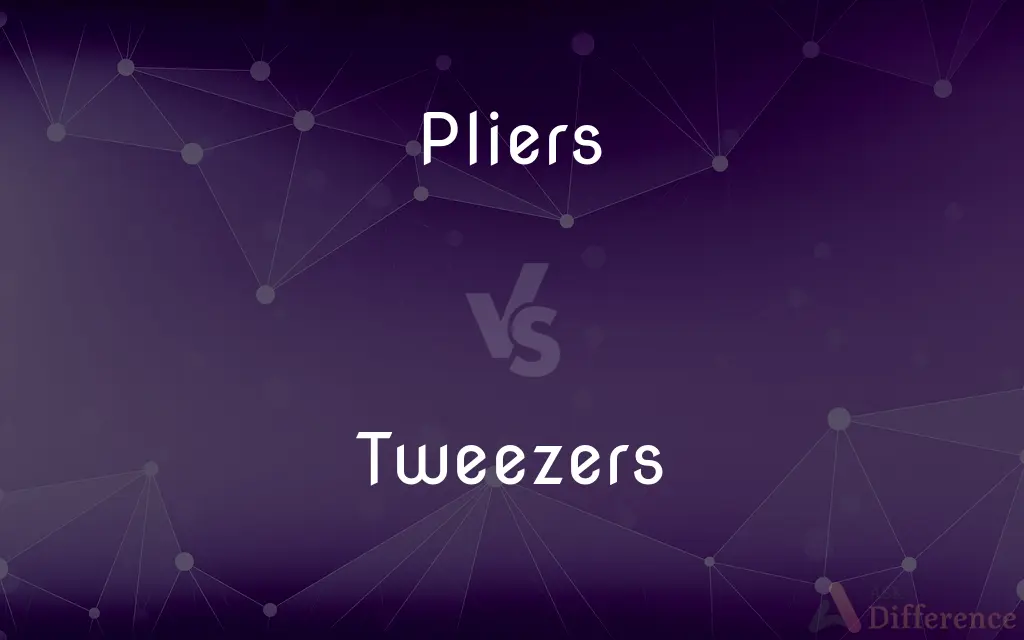Pliers vs. Tweezers — What's the Difference?
Edited by Tayyaba Rehman — By Fiza Rafique — Updated on March 13, 2024
Pliers are tools designed for gripping, bending, or cutting materials, while tweezers are small tools used for picking up or holding small objects.

Difference Between Pliers and Tweezers
Table of Contents
ADVERTISEMENT
Key Differences
Pliers are versatile tools with pairs of metal levers joined at a fulcrum, designed primarily for gripping, bending, twisting, or cutting wires and other materials. They come in various sizes and designs, such as needle-nose pliers for precision work and lineman's pliers for electrical tasks. On the other hand, tweezers are much smaller and are used for tasks that require precision, such as plucking hair, handling small electronic components, or doing detailed craftwork. Tweezers consist of two arms that are pinched together by the user to grip small objects.
While pliers are used in a wide range of applications from electrical work to jewelry making, showcasing their versatility in both domestic and professional settings, tweezers are essential for delicate tasks where precise control over small objects is necessary. The design of pliers allows for the exertion of greater force on an object, which is useful for cutting wires or bending heavy gauge materials. In contrast, tweezers are designed for tasks that require fine motor skills and accuracy rather than force.
Pliers often have insulated handles for safety when working with electricity, and their jaws may have different textures or patterns to grip objects securely. Tweezers, however, may have tips that are pointed, flat, or even specially designed for specific tasks, such as applying false eyelashes or manipulating tiny electronic components. The distinction in their design reflects the difference in their primary functions: pliers for handling tougher materials with force and tweezers for precise manipulation of small items.
The choice between pliers and tweezers depends on the nature of the task at hand. For heavy-duty tasks requiring manipulation of wires or materials, pliers are the go-to tool. Conversely, for tasks that involve handling small, delicate objects where precision is paramount, tweezers are more appropriate. Both tools, however, are indispensable in their respective domains, highlighting the importance of using the right tool for the job.
Comparison Chart
Primary Use
Gripping, bending, cutting materials
Picking up, holding small objects
ADVERTISEMENT
Size
Larger, requires a full grip
Smaller, operated with precision by fingers
Design
Metal levers joined at a fulcrum
Two arms pinched together
Application
Electrical work, jewelry making, plumbing
Plucking hair, handling electronics, crafts
Force
Designed to exert greater force
Designed for precision, not force
Handle
Often insulated for safety
Simple design, focus on precision
Jaw Design
Various textures for gripping
Tips vary (pointed, flat) for specific tasks
Compare with Definitions
Pliers
Cutting Capability.
Some pliers, like side cutters, are used to cut wires.
Tweezers
Precision Handling.
Tweezers are used for plucking eyebrows with precision.
Pliers
Gripping Tools.
Pliers are essential for gripping and twisting wires in electrical installations.
Tweezers
Specialized Types.
Antistatic tweezers are made for handling sensitive electronic parts.
Pliers
Safety Features.
The insulated handles on electrician's pliers protect against electric shock.
Tweezers
Small Object Manipulation.
Tweezers allow for the placement of small components on circuit boards.
Pliers
Versatile Designs.
Needle-nose pliers are designed for precision tasks in tight spaces.
Tweezers
Medical Applications.
Surgical tweezers are used for removing splinters or debris from wounds.
Pliers
Heavy-Duty Use.
Lineman's pliers are robust for cutting and gripping heavy gauge wires.
Tweezers
Crafts and Beauty.
Tweezers are indispensable for applying small decorations or false eyelashes.
Pliers
Pliers are a hand tool used to hold objects firmly, possibly developed from tongs used to handle hot metal in Bronze Age Europe. They are also useful for bending and compressing a wide range of materials.
Tweezers
Tweezers are small tools used for picking up objects too small to be easily handled with the human fingers. The tool is most likely derived from tongs, pincers, or scissors-like pliers used to grab or hold hot objects since the dawn of recorded history.
Pliers
Pincers with parallel, flat, and typically serrated surfaces, used chiefly for gripping small objects or bending wire
A pair of pliers
Tweezers
A small pincerlike instrument, usually made of metal, used for handling or picking up small objects (such as postage stamps), plucking out (plucking) hairs, pulling out slivers, etc.
Pliers
One who plies a trade.
Tweezers
Small pinchers used to pluck out hairs, and for other purposes.
Pliers
Pliers A variously shaped hand tool having a pair of pivoted jaws, used for holding, bending, or cutting.
Pliers
A pincer-like gripping tool that multiplies the strength of the user's hand, often used for bending things.
I need a pair of pliers to get a good grip on that broken screw.
Pliers
A kind of small pinchers with long jaws, - used for bending or cutting metal rods or wire, for handling small objects such as the parts of a watch, etc.
Pliers
A gripping hand tool with two hinged arms and (usually) serrated jaws
Common Curiosities
Are there different types of pliers and tweezers?
Yes, both tools come in various designs for specific tasks, such as needle-nose pliers for precision work and pointed tweezers for fine picking.
Can tweezers be used as pliers?
Tweezers are not designed to replace pliers, especially for tasks requiring force or manipulation of heavy materials.
What are tweezers used for?
Tweezers are used for picking up, holding, or manipulating small objects with precision.
Can tweezers be used in medical applications?
Yes, specialized tweezers are used in medical settings for tasks like removing splinters or handling sterile materials.
What are pliers used for?
Pliers are used for gripping, bending, twisting, or cutting materials, especially in tasks requiring force.
Why do some pliers have insulated handles?
Insulated handles protect against electrical shock, making them safe for electrical work.
How do I maintain pliers and tweezers?
Keep them clean, dry, and occasionally lubricate moving parts to ensure smooth operation.
How do I choose between pliers and tweezers?
Choose based on the task: pliers for tasks requiring force on larger objects, and tweezers for precise manipulation of small items.
Do pliers and tweezers require special skills to use?
Basic operation is straightforward, but effective use, especially for specific tasks, may require practice and skill.
What materials are pliers and tweezers made from?
They are typically made from steel, with variations like stainless steel or coated materials for specific uses.
Share Your Discovery

Previous Comparison
Nay vs. Yes
Next Comparison
Collectibility vs. CollectabilityAuthor Spotlight
Written by
Fiza RafiqueFiza Rafique is a skilled content writer at AskDifference.com, where she meticulously refines and enhances written pieces. Drawing from her vast editorial expertise, Fiza ensures clarity, accuracy, and precision in every article. Passionate about language, she continually seeks to elevate the quality of content for readers worldwide.
Edited by
Tayyaba RehmanTayyaba Rehman is a distinguished writer, currently serving as a primary contributor to askdifference.com. As a researcher in semantics and etymology, Tayyaba's passion for the complexity of languages and their distinctions has found a perfect home on the platform. Tayyaba delves into the intricacies of language, distinguishing between commonly confused words and phrases, thereby providing clarity for readers worldwide.













































